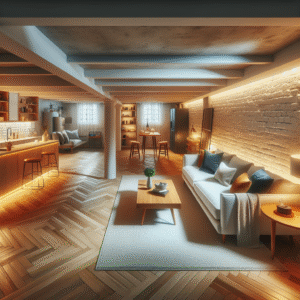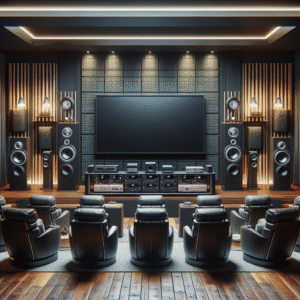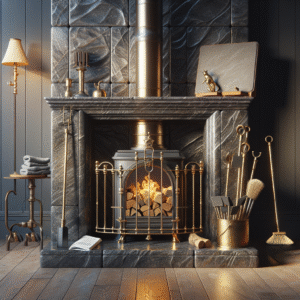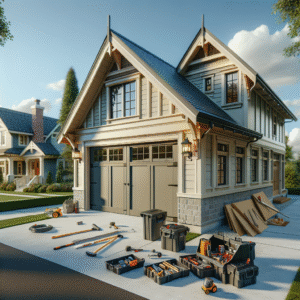Remodeling a bathroom is one of the most effective ways to enhance the functionality, comfort, and value of your home. Whether you’re looking to update an outdated design, add modern amenities, or create a spa-like retreat, a well-planned bathroom remodel can make a significant impact. However, a successful remodel requires careful planning, budgeting, and coordination to ensure that the project runs smoothly and stays within your financial limits. In this step-by-step guide, we’ll walk you through the process of planning a bathroom remodel, from initial design ideas to final touches, helping you achieve the bathroom of your dreams.
1. Define Your Goals and Budget
Before diving into the details of your bathroom remodel, it’s essential to start with clear goals and a realistic budget. Understanding what you want to achieve and how much you’re willing to spend will guide your decisions throughout the project.
1.1 Identify Your Priorities
- Functionality: Consider the primary purpose of the bathroom. Is it a master bathroom, guest bathroom, or powder room? Your goals may differ based on who will use the space and how often. For example, a master bathroom may require more luxurious features, while a guest bathroom might focus on practicality.
- Aesthetics: Think about the overall look and feel you want to achieve. Are you aiming for a modern, minimalist design, a classic and timeless look, or something more unique? Collect inspiration from magazines, websites, and social media platforms like Pinterest to help define your style.
- Resale Value: If you’re remodeling with an eye on selling your home in the future, consider how your choices will affect resale value. While it’s essential to create a space that meets your needs, choosing neutral colors, high-quality materials, and popular features can make your home more appealing to potential buyers.
1.2 Set a Budget
- Determine Your Budget: Establish a budget that reflects your goals and financial situation. Keep in mind that bathroom remodels can range from a few thousand dollars for minor updates to $20,000 or more for a complete overhaul. Be sure to factor in unexpected costs, such as hidden water damage or structural issues, by setting aside an additional 10-20% of your budget as a contingency fund.
- Prioritize Spending: Decide where to allocate your budget based on your priorities. For example, if you want to invest in a high-end shower system or custom cabinetry, you may need to save on other aspects, such as fixtures or tile choices.
2. Design Your Bathroom Layout and Features
Once you’ve defined your goals and budget, it’s time to start planning the layout and features of your new bathroom. This stage involves making decisions about the layout, fixtures, materials, and overall design.
2.1 Consider the Layout
- Existing Layout vs. New Layout: Decide whether you want to keep the existing layout or completely reconfigure the space. Keeping the current layout can save money on plumbing and electrical work, while a new layout allows you to optimize the space for better functionality.
- Maximize Space: Consider how you can make the most of the available space, especially if you have a small bathroom. For example, a corner shower, wall-mounted sink, or built-in storage can help maximize floor space and make the room feel larger.
- Accessibility: If you’re planning to stay in your home for the long term, consider incorporating accessibility features such as a walk-in shower, grab bars, or a comfort-height toilet. These features can make the bathroom safer and more functional for people of all ages and abilities.
2.2 Choose Fixtures and Features
- Shower/Bath: Decide whether you want a shower, bathtub, or both. Consider options such as a walk-in shower with a frameless glass enclosure, a freestanding tub, or a combination shower/tub unit. Features like rain showerheads, body sprays, and built-in niches can add luxury and convenience.
- Vanity and Sink: The vanity is a focal point of the bathroom, so choose a style that complements your design. Consider whether you need a single or double sink, the amount of storage required, and the type of countertop material. Quartz, granite, and marble are popular choices for durability and aesthetics.
- Toilet: While it may seem like a straightforward choice, toilets come in various styles and features. Consider a water-saving model, a wall-mounted toilet for a modern look, or a bidet for added comfort.
- Lighting: Proper lighting is essential for both functionality and ambiance. Plan for a combination of task lighting (such as vanity lights), ambient lighting (such as ceiling fixtures), and accent lighting (such as wall sconces or LED strips). Consider dimmer switches to control the mood of the room.
- Storage: Adequate storage is crucial in any bathroom. Plan for built-in shelving, medicine cabinets, or custom cabinetry to keep toiletries, towels, and cleaning supplies organized and easily accessible.
3. Select Materials and Finishes
The materials and finishes you choose will significantly impact the look, feel, and durability of your bathroom. Take time to select materials that align with your design goals and budget.
3.1 Flooring
- Tile: Ceramic, porcelain, and natural stone tiles are popular choices for bathroom floors due to their water resistance and durability. Choose a non-slip surface for safety, especially in wet areas.
- Heated Floors: Consider installing radiant floor heating for added comfort, especially in colder climates. While this is an additional expense, it can enhance the overall luxury of your bathroom.
3.2 Walls and Backsplashes
- Tile: Wall tiles can create a sleek and modern look, especially in the shower or around the bathtub. Subway tiles, mosaics, and large-format tiles are popular options.
- Paint: For non-wet areas, choose a high-quality, moisture-resistant paint that can withstand the humidity of a bathroom. Light colors can make a small bathroom feel more spacious, while darker colors can add drama and sophistication.
- Accent Walls: Consider adding an accent wall with a different material or color to create visual interest. This could be a feature wall behind the vanity, in the shower, or around the bathtub.
3.3 Countertops
- Material Options: Countertops come in various materials, including quartz, granite, marble, and solid surface. Consider durability, maintenance requirements, and aesthetic appeal when making your selection.
- Edge Profiles: The edge profile of the countertop can add a subtle design detail. Common options include straight, beveled, and bullnose edges.
4. Hire the Right Professionals
Depending on the scope of your bathroom remodel, you may need to hire several professionals, including a general contractor, plumber, electrician, and possibly a designer. Choosing the right team is crucial to the success of your project.
4.1 Finding a General Contractor
- Research and Recommendations: Start by asking for recommendations from friends, family, or neighbors who have recently completed similar projects. Check online reviews and ratings on platforms like Google, Yelp, and Angie’s List.
- Credentials and Licensing: Verify that the contractor is licensed, insured, and has the necessary permits to perform the work in your area. Ask for references from past clients and review their portfolio of completed projects.
- Detailed Contract: Ensure the contract outlines the scope of work, timeline, payment schedule, and any warranties or guarantees. Be wary of contractors who ask for a large upfront payment or who offer significantly lower bids than others.
4.2 Hiring a Designer
- Design Expertise: If you’re looking for a more custom or high-end bathroom design, consider hiring an interior designer. A designer can help you create a cohesive look, select materials, and maximize space.
- Collaboration: Ensure the designer works closely with the contractor to ensure that the design vision is implemented correctly and within budget.
5. Prepare for Construction
Once your design is finalized and your team is in place, it’s time to prepare for the construction phase of your bathroom remodel. This stage involves setting expectations, preparing your home, and staying involved in the process.
5.1 Timeline and Communication
- Project Timeline: Work with your contractor to establish a realistic timeline for the project. Be prepared for potential delays, especially if unexpected issues arise during demolition.
- Regular Updates: Stay in regular communication with your contractor and designer throughout the project. Schedule regular check-ins to discuss progress, address any concerns, and make decisions as needed.
5.2 Preparing Your Home
- Clear the Space: Remove all personal items, toiletries, and décor from the bathroom before construction begins. If the bathroom is connected to a bedroom, consider covering furniture and bedding to protect them from dust and debris.
- Alternative Bathroom: If the bathroom being remodeled is your primary bathroom, plan for alternative bathroom arrangements during the construction period. This could involve using a secondary bathroom in the home or arranging for temporary facilities.
6. Final Touches and Inspection
As your bathroom remodel nears completion, focus on the final touches and ensure that everything meets your expectations.
6.1 Finishing Touches
- Fixtures and Hardware: Install fixtures, hardware, and accessories such as towel bars, mirrors, and shower curtains. These details can pull the design together and add functionality.
- Cleaning: Ensure the space is thoroughly cleaned after construction is complete. This includes removing construction dust, polishing surfaces, and cleaning the grout.
6.2 Final Inspection
- Walkthrough: Conduct a final walkthrough with your contractor to inspect the work and ensure everything is completed to your satisfaction. Check for any issues such as leaks, loose fixtures, or unfinished details.
- Address Any Issues: If any issues are identified, work with your contractor to resolve them promptly. Ensure that all work is completed before making the final payment








